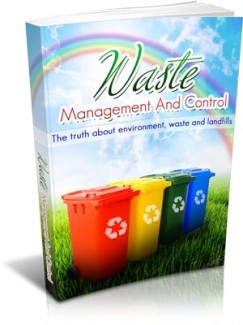 License Type: Giveaway Rights
License Type: Giveaway Rights  File Size: 5,040 KB
File Size: 5,040 KB File Type: ZIP
File Type: ZIP
 SKU: 52928
SKU: 52928  Shipping: Online Download
Shipping: Online Download
Ebook Sample Content Preview:
Chapter 6: Understanding Biodegradable and Non-Biodegradable Materials
The primary difference between biodegradable and non-biodegradable materials is with biodegradable, items break down or decompose naturally, and non-biodegradable they do not. This specific difference is most crucial when talking about waste disposal and landfills. Understand more about these types of materials in this chapter.
Biodegradable and Non-Biodegradable
Everything around you can be determined as biodegradable or non-biodegradable. You can find banana peels, leaves and chicken bones as examples of biodegradable. Cans, candy wrappers and Styrofoam are non-biodegradable. In one way or another, things might confuse you on whether these materials are biodegradable or not. That is a threat to take and the whole environment could be at threat. Hence, determining what biodegradable and non-biodegradable are could aid in preventing water and air pollution. Proper separating of wastes could surely offer solution against those environmental problems.
Non-Biodegradable
Non-biodegradable things can’t dissolve or break down for several years. Rather, they can become useful once again so they are called recyclable. Therefore, any waste that is thrown inside the garbage could be dumped within a recycling center or factory that could make them functional for other things. Get thin boards and papers as your examples. These materials don’t normally dissolve and disappear though they shrink. However, they may stay as debris on water, holes and more that might eventually bring damage to the environment. Hence, they are gathered to be cut into pieces until they form once again as new pieces of paper.
Non-biodegradable items just can’t be affected by the natural process. They don’t dissolve and react easily on the soil. Few of those items that are really common to utilize again at homes include glasses, aluminum cans, plastic products, grocery bags, bottles, other plastic bags or metal scraps and even polystyrene or commonly known as Styrofoam. Along with other non-biodegradable items, these need to be properly stored after utilization for recycling.
Biodegradable
Conversely, biodegradable materials are items that may easily dissolve, break and fade away over time. Similar to solid and bacteria or other micro-organism, they go through natural process within a slow or quick yet definitely not a risk to the environment. Few of the wastes that putrefy into the soil are egg shells, kitchen food scraps and garden wastes. They are dissembled and destroyed by biological or natural elements that may include oxygen or air, UV light from the sun, as well as the nitric acid coming from the rain. Some other elements may also include critters or microscopic elements and soil.
Normally, the disparity between biodegradable and non-biodegradable materials is based their impacts to both environment and health. However, you could aid your own government and other organizations when it comes to saving the environment against water and air pollutions. Primarily, you can reuse and recycle items that are non-biodegradable. Secondly, you can separate biodegradable items from the non-biodegradable ones.
Chapter 7: The Negative Impact Of Landfill Gas (LFG) To The Environment
Landfill Gas is not similar as “methane” or “natural gas”. These are 3 separate terms that mean various things so they must not be utilized interchangeably. To understand more about Landfill Gas (LFG), read on the following chapter.
In Depth Understanding of Landfill Gas and Its Effects
Landfill Gas is the complex blend of various gases produced by the action of microorganisms in a landfill.
Production of landfill gas leads from microbes and chemical reactions that act on the waste as putrescible materials start to decompose within the landfill. The production rate is normally affected by landfill geometry and waste composition that in turn persuade the microbial populations in it, physical conditions’ thermal range, chemical waste composition, and the natural ecosystems that co-exist simultaneously in most sites. Together with the normally vague nature of contents, this heterogeneity makes the production of landfill gas harder for control and prediction than those typical industrial bioreactors that are used for sewage treatment.
Because of the continuous landfill gas production, the boost of pressure in the landfill (along with disparity diffusion) leads the gases to be released into the atmosphere. These emissions may result to crucial security, hygiene and environmental problems within the landfill. A number of accidents have taken place, for instance in 1986 at Loscoe, England in which migrating landfill gas that was enabled to accumulate partly destroyed the property.
Another accident caused 2 deaths because of the explosion inside the house near the Skellingsted landfill within Denmark that happened in 1991. Because of the threat displayed by landfill gas, the need for monitoring the gas being produced by landfills is clear. Aside from the threat of explosion and fire, gas migration within the subsurface could lead to letting landfill gas get in contact with groundwater. In turn, this may lead to groundwater contamination by organic compounds existent in almost all landfill gas.
Landfill gas is about 40 to 60% methane, with the rest being mainly carbon dioxide. Also, it contains different amounts of oxygen and nitrogen gas, hydrogen sulphide, water vapor, and some other contaminants. The majority of these contaminants are recognized as “non-methane organic compounds” (NMOCs). In addition, some inorganic contaminants like mercury are existent in some landfill gases. Sometimes, there are also some radioactive contaminants, like tritium, found within the landfill gas. Usually, the non-methane organic compounds compose less than 1% of landfill gas. In 1991, the United States EPA determined 94 non-methane organic compounds that include toxic chemicals such as touene, benzene, carbon tetrachloride, chloroform, and vinyl chloride. No less than 41 of the total non-methane organic compounds are considered as halogenated compounds or the chemicals that contains halogens like bromine, chlorine or fluorine.
Common options for landfill gas include boiler, flaring, gas turbine, internal combustion engine, converting methane to methyl alcohol, sufficient cleaning to pipe into lines of natural gas or to some other industries.
The Environmental Protection Agency has estimated that those are about 6,000 landfills within the US. Most of those landfills have been composed of municipal waste and so generate methane. Those landfills are considered to be the biggest sources of anthropogenic methane emissions within the US. These landfills will add the estimated 450 to 650 billion cubic ft of methane each year during 2000.
Landfill gases display some effects on climate change. Two of the primary components include methane and C02. Both of these are greenhouse gases. Methane has been considered to be twenty times more damaging to the environment as compared to Carbon Dioxide.
- File Size:5,040 KB
- License: Giveaway Rights
- Category:Ebooks
- Tags:2015 Ebooks Give Away Rights








